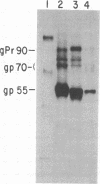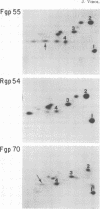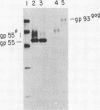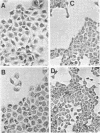Abstract
Rauscher spleen focus-forming virus (SFFV) was cloned free of its helper virus into normal rat kidney and mouse fibroblasts, and the resulting nonproducer fibroblast clones were analyzed. Our results suggested that Rauscher SFFV encodes a glycoprotein with an apparent Mr of 54,000 (gp54) that reacts with antisera made to the envelope glycoprotein (gp70) of ecotropic murine leukemia viruses, as well as with a rat antiserum that reacts with the gp70's of dual-tropic mink cell focus-inducing and HIX viruses but not with the gp70's of ecotropic viruses. In these respects and in its tryptic peptide map, Rauscher SFFV-encoded gp54 is nearly identical to the gp55 glycoprotein which we previously reported to be encoded by Friend SFFV (Dresler et al., J. Virol. 30:564--575, 1979). However, gp54 is slightly smaller, and it lacks one methionine-containing tryptic peptide that occurs in gp55. Studies with cytotoxic antiserum in the presence of complement and with a rosetting technique which employed sheep erythrocytes coupled to protein A suggested that the gp54 and gp55 glycoproteins are weakly expressed on the surface membranes of SFFV-infected cells. In addition, the Rauscher SFFV genome also encodes gag polyproteins which appear to be identical to the gag polyproteins encoded by helper Rauscher murine leukemia virus, but differ from the antigenically related polyproteins encoded by some but not all clones of Friend SFFV. Furthermore, the glycosylated gag polyproteins encoded by Rauscher SFFV and by some Friend SFFVs also appear to be expressed on the surface membranes of infected cells. These results suggest that similar env gene recombination and partial deletion events were involved in the independent origins of two different strains of acute erythroleukemia virus.
Full text
PDF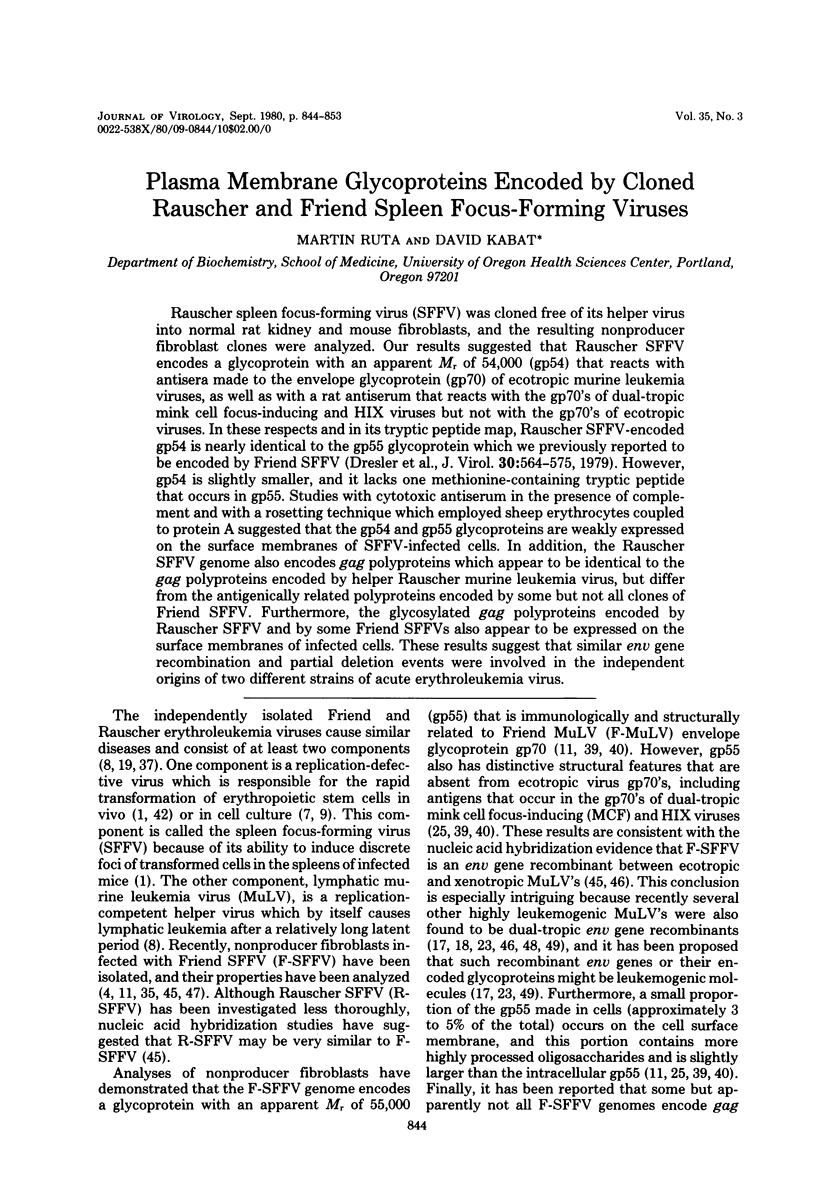
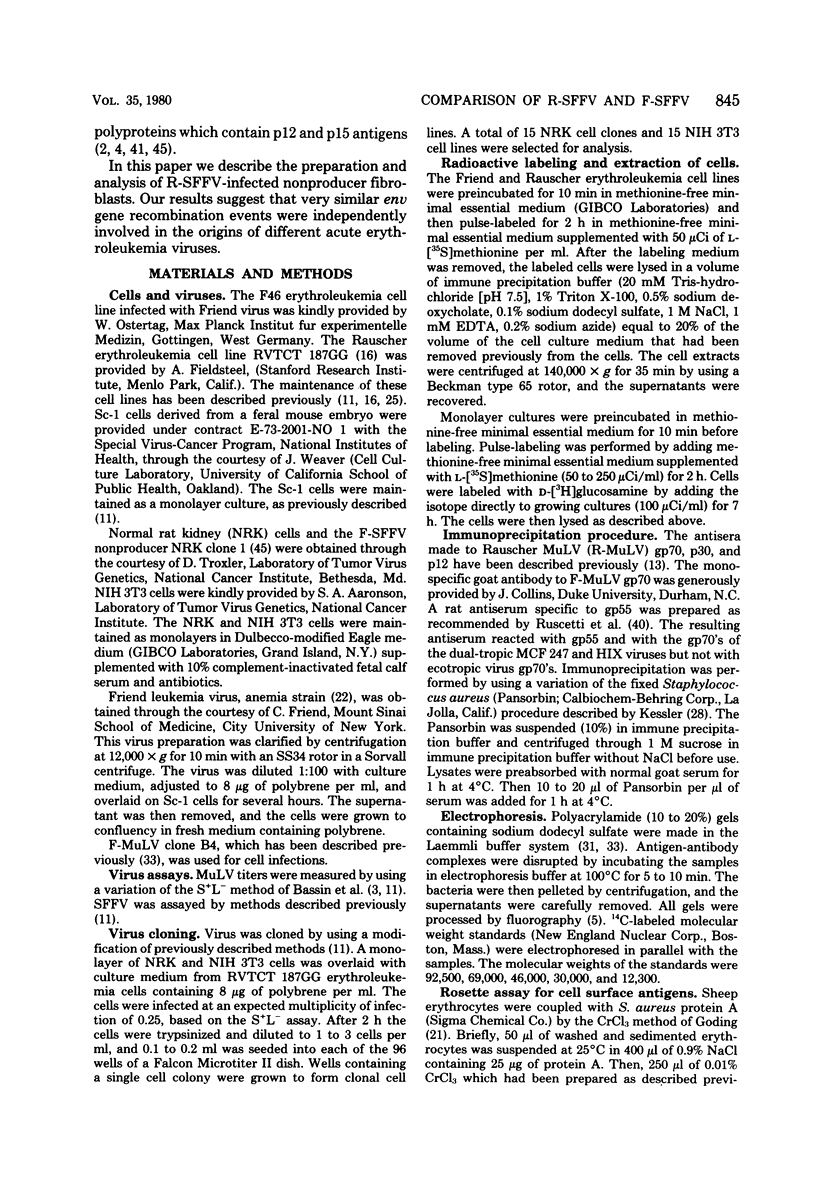
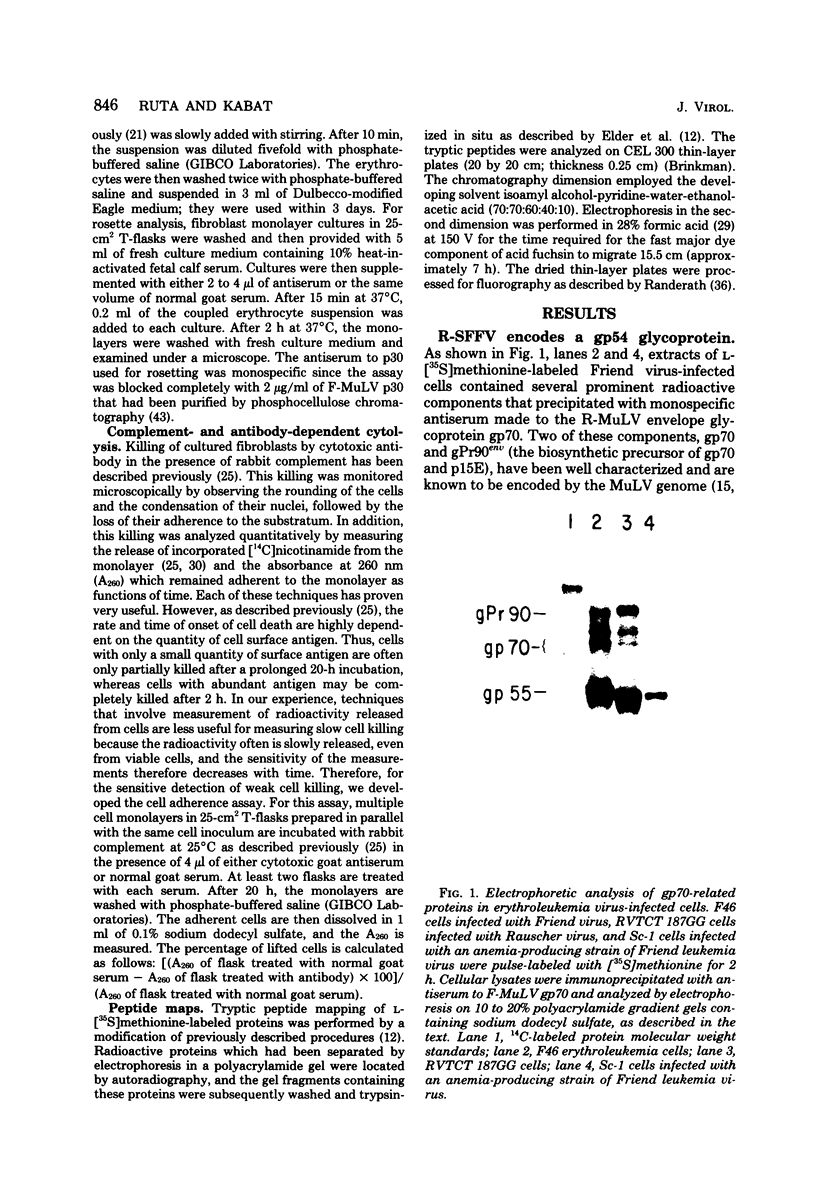
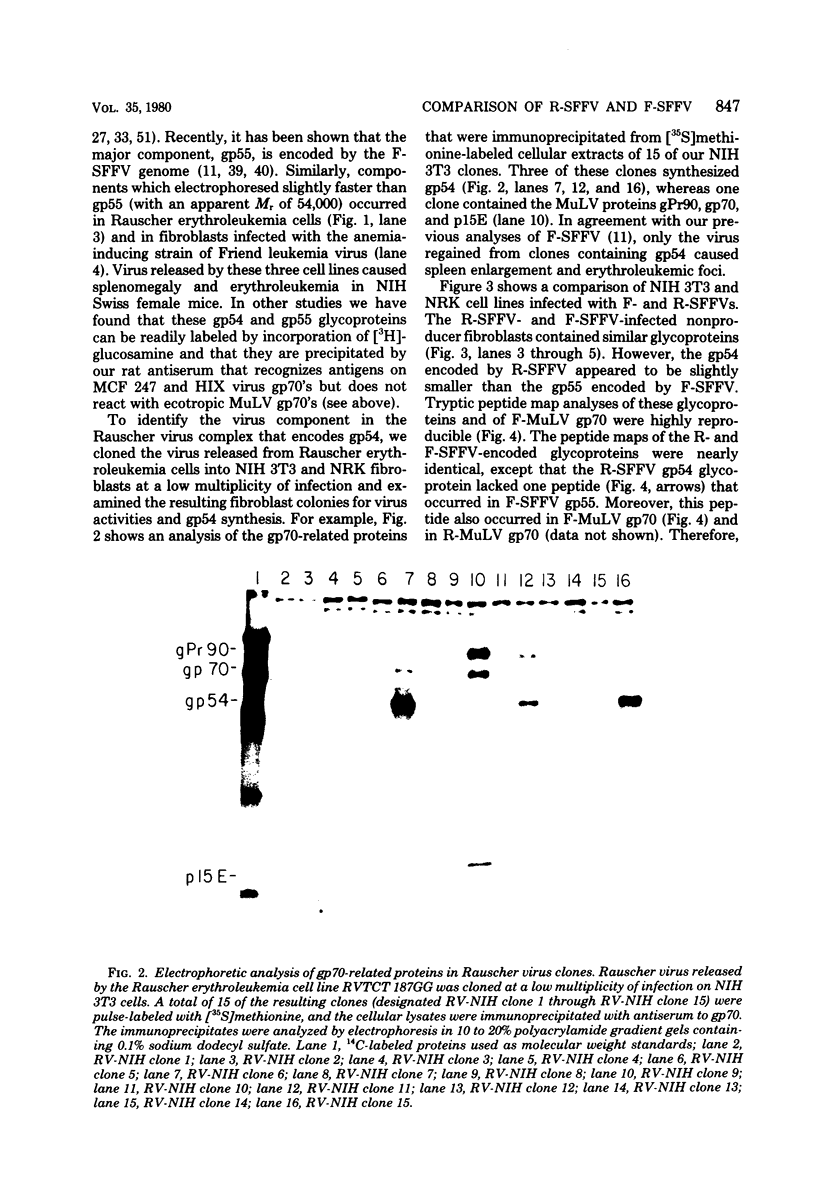
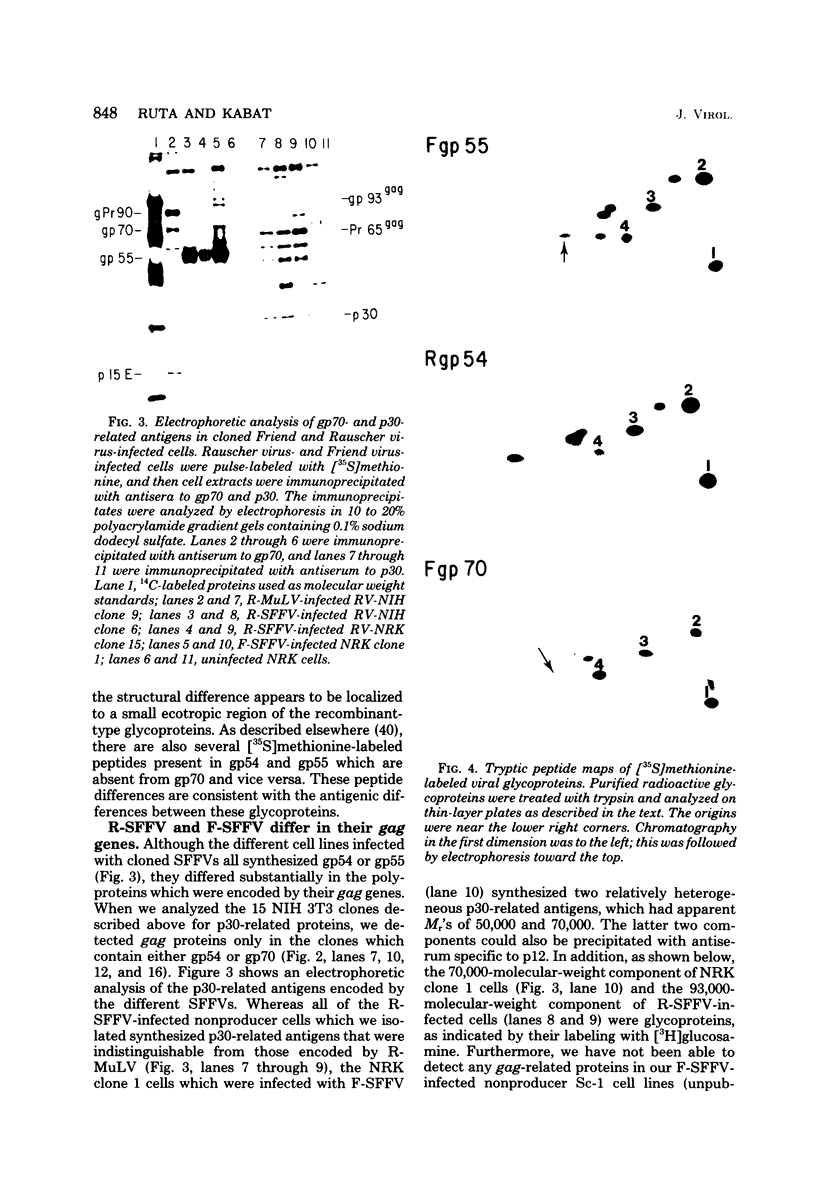
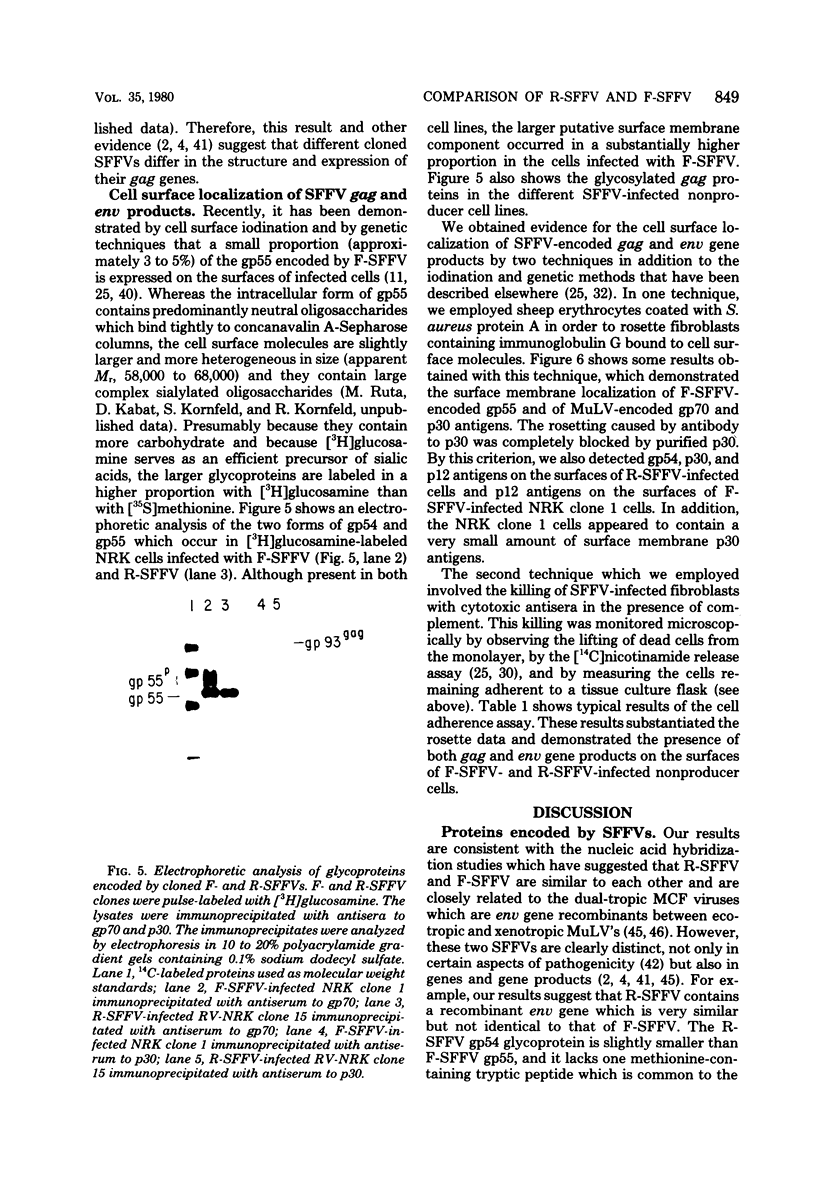
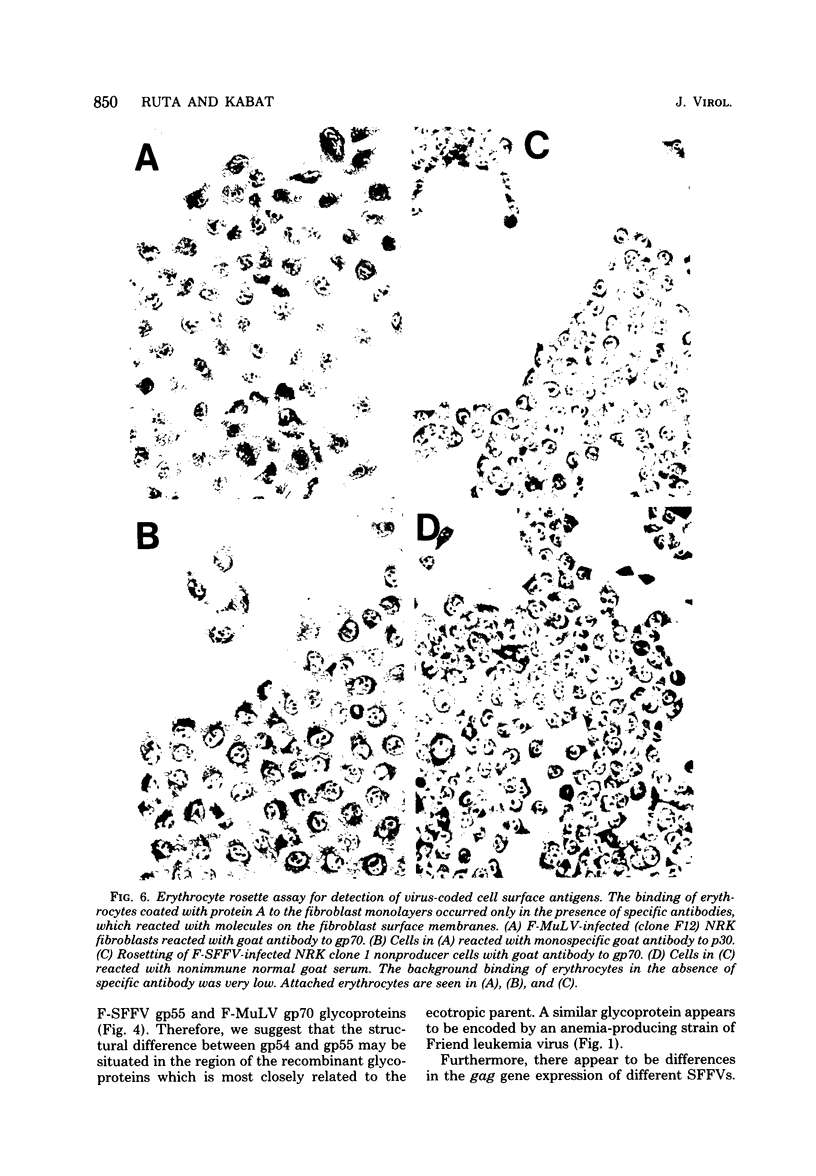
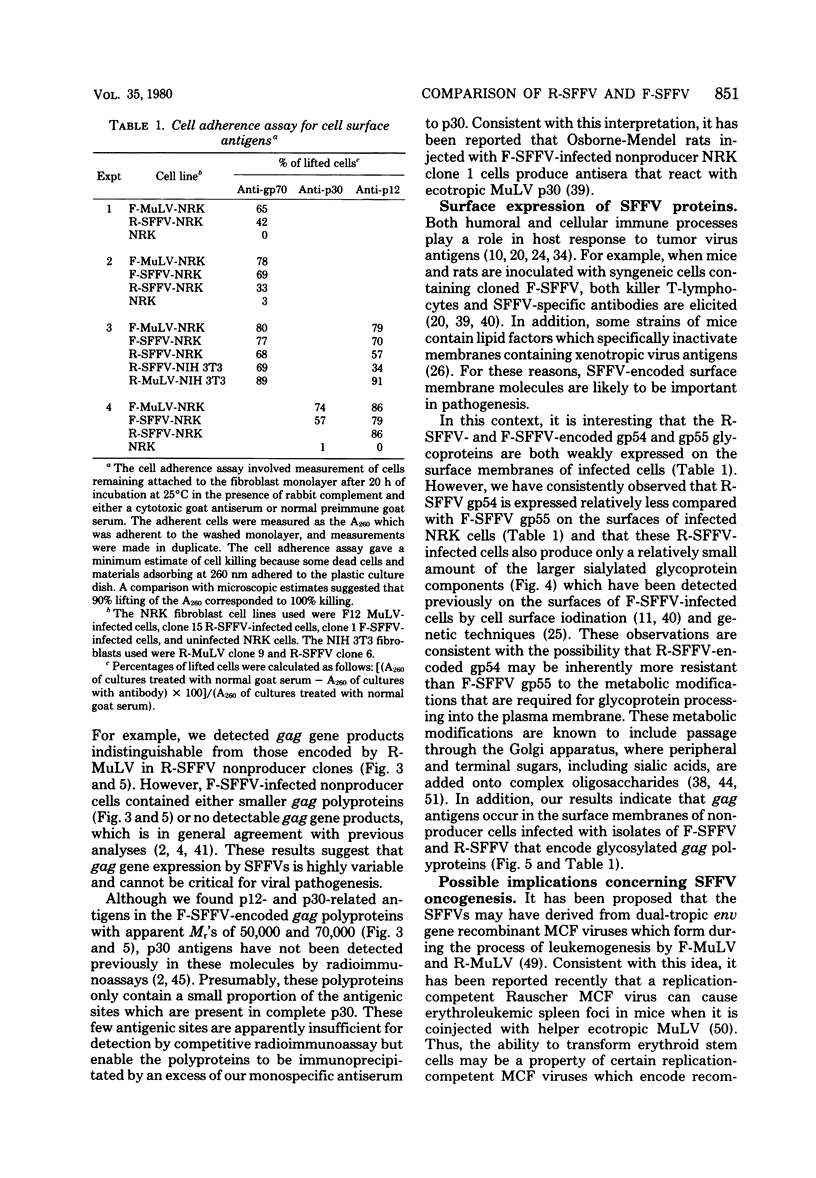
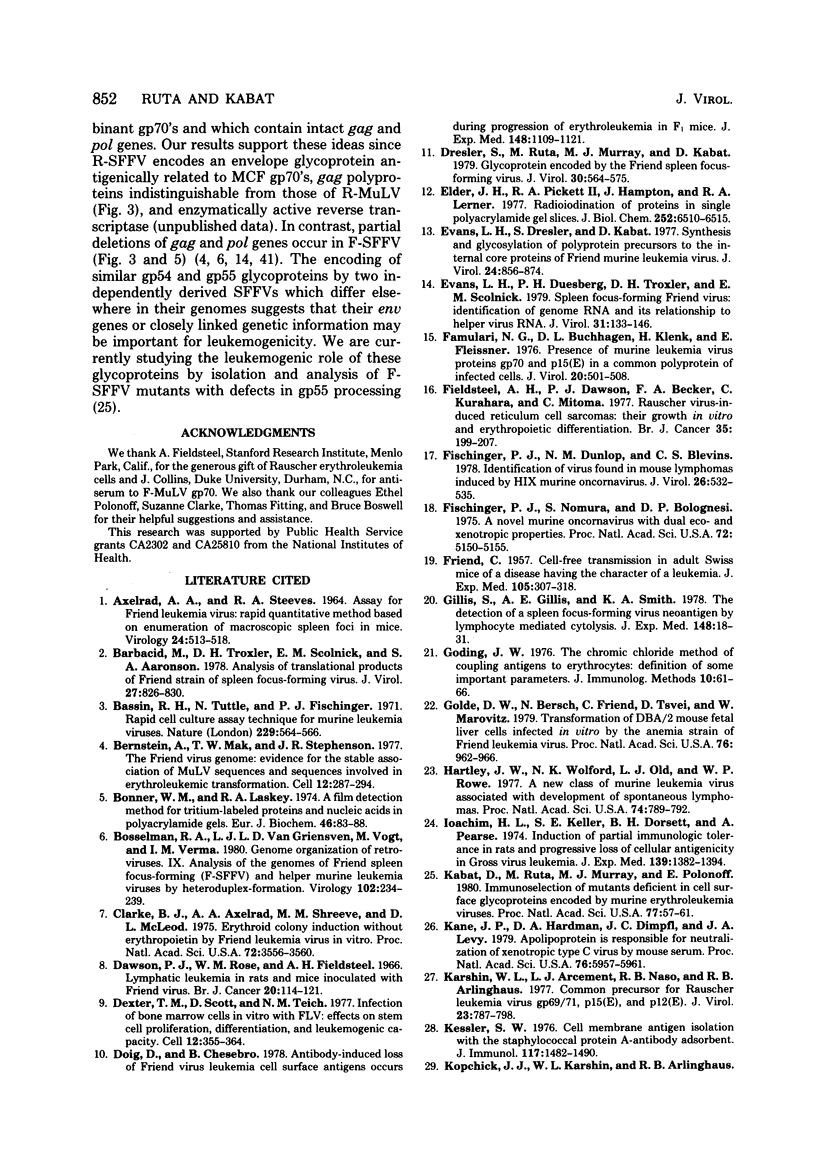

Images in this article
Selected References
These references are in PubMed. This may not be the complete list of references from this article.
- AXELRAD A. A., STEEVES R. A. ASSAY FOR FRIEND LEUKEMIA VIRUS: RAPID QUANTITATIVE METHOD BASED ON ENUMERATION OF MACROSCOPIC SPLEEN FOCI IN MICE. Virology. 1964 Nov;24:513–518. doi: 10.1016/0042-6822(64)90199-0. [DOI] [PubMed] [Google Scholar]
- Barbacid M., Troxler D. H., Scolnick E. M., Aaronson S. A. Analysis of translational products of Friend strain of spleen focus-forming virus. J Virol. 1978 Sep;27(3):826–830. doi: 10.1128/jvi.27.3.826-830.1978. [DOI] [PMC free article] [PubMed] [Google Scholar]
- Bassin R. H., Tuttle N., Fischinger P. J. Rapid cell culture assay technic for murine leukaemia viruses. Nature. 1971 Feb 19;229(5286):564–566. doi: 10.1038/229564b0. [DOI] [PubMed] [Google Scholar]
- Bernstein A., Mak T. W., Stephenson J. R. The Friend virus genome: evidence for the stable association of MuLV sequences and sequences involved in erythroleukemic transformation. Cell. 1977 Sep;12(1):287–294. doi: 10.1016/0092-8674(77)90206-9. [DOI] [PubMed] [Google Scholar]
- Bonner W. M., Laskey R. A. A film detection method for tritium-labelled proteins and nucleic acids in polyacrylamide gels. Eur J Biochem. 1974 Jul 1;46(1):83–88. doi: 10.1111/j.1432-1033.1974.tb03599.x. [DOI] [PubMed] [Google Scholar]
- Bosselman R. A., Van Griensven L. J., Vogt M., Verma I. M. Genome organization of retroviruses IX. Analysis of the genomes of Friend spleen focus-forming (F-SFFV) and helper murine leukemia viruses by heteroduplex-formation. Virology. 1980 Apr 15;102(1):234–239. doi: 10.1016/0042-6822(80)90088-4. [DOI] [PubMed] [Google Scholar]
- Clarke B. J., Axelrad A. A., Shreeve M. M., McLeod D. L. Erythroid colony induction without erythropoietin by Friend leukemia virus in vitro. Proc Natl Acad Sci U S A. 1975 Sep;72(9):3556–3560. doi: 10.1073/pnas.72.9.3556. [DOI] [PMC free article] [PubMed] [Google Scholar]
- Dawson P. J., Rose W. M., Fieldsteel A. H. Lymphatic leukaemia in rats and mice inoculated with Friend virus. Br J Cancer. 1966 Mar;20(1):114–121. doi: 10.1038/bjc.1966.12. [DOI] [PMC free article] [PubMed] [Google Scholar]
- Dexter T. M., Scott D., Teich N. M. Infection of bone marrow cells in vitro with FLV: effects on stem cell proliferation, differentiation and leukemogenic capacity. Cell. 1977 Oct;12(2):355–364. doi: 10.1016/0092-8674(77)90111-8. [DOI] [PubMed] [Google Scholar]
- Doig D., Chesebro B. Antibody-induced loss of Friend virus leukemia cell surface antigens occurs during progression of erythroleukemia in F1 mice. J Exp Med. 1978 Nov 1;148(5):1109–1121. doi: 10.1084/jem.148.5.1109. [DOI] [PMC free article] [PubMed] [Google Scholar]
- Dresler S., Ruta M., Murray M. J., Kabat D. Glycoprotein encoded by the Friend spleen focus-forming virus. J Virol. 1979 May;30(2):564–575. doi: 10.1128/jvi.30.2.564-575.1979. [DOI] [PMC free article] [PubMed] [Google Scholar]
- Elder J. H., Pickett R. A., 2nd, Hampton J., Lerner R. A. Radioiodination of proteins in single polyacrylamide gel slices. Tryptic peptide analysis of all the major members of complex multicomponent systems using microgram quantities of total protein. J Biol Chem. 1977 Sep 25;252(18):6510–6515. [PubMed] [Google Scholar]
- Evans L. H., Dresler S., Kabat D. Synthesis and glycosylation of polyprotein precursors to the internal core proteins of Friend murine leukemia virus. J Virol. 1977 Dec;24(3):865–874. doi: 10.1128/jvi.24.3.865-874.1977. [DOI] [PMC free article] [PubMed] [Google Scholar]
- Evans L. H., Duesberg P. H., Troxler D. H., Scolnick E. M. Spleen focus-forming Friend virus: identification of genomic RNA and its relationship to helper virus RNA. J Virol. 1979 Jul;31(1):133–146. doi: 10.1128/jvi.31.1.133-146.1979. [DOI] [PMC free article] [PubMed] [Google Scholar]
- FRIEND C. Cell-free transmission in adult Swiss mice of a disease having the character of a leukemia. J Exp Med. 1957 Apr 1;105(4):307–318. doi: 10.1084/jem.105.4.307. [DOI] [PMC free article] [PubMed] [Google Scholar]
- Famulari N. G., Buchhagen D. L., Klenk H. D., Fleissner E. Presence of murine leukemia virus envelope proteins gp70 and p15(E) in a common polyprotein of infected cells. J Virol. 1976 Nov;20(2):501–508. doi: 10.1128/jvi.20.2.501-508.1976. [DOI] [PMC free article] [PubMed] [Google Scholar]
- Fieldsteel A. H., Dawson P. J., Becker F. A., Kurahara C., Mitoma C. Rauscher virus-induced reticulum-cell sarcomas: Their growth in vitro and erythropoietic differentiation. Br J Cancer. 1977 Feb;35(2):199–207. doi: 10.1038/bjc.1977.27. [DOI] [PMC free article] [PubMed] [Google Scholar]
- Fischinger P. J., Dunlop N. M., Blevins C. S. Identification of virus found in mouse lymphomas induced by HIX murine oncornavirus. J Virol. 1978 May;26(2):532–535. doi: 10.1128/jvi.26.2.532-535.1978. [DOI] [PMC free article] [PubMed] [Google Scholar]
- Fischinger P. J., Nomura S., Bolognesi D. P. A novel murine oncornavirus with dual eco- and xenotropic properties. Proc Natl Acad Sci U S A. 1975 Dec;72(12):5150–5155. doi: 10.1073/pnas.72.12.5150. [DOI] [PMC free article] [PubMed] [Google Scholar]
- Gillis S., Gillis A. E., Smith K. A. The detection of a spleen focus-forming virus neoantigen by lymphocyte-mediated cytolysis. J Exp Med. 1978 Jul 1;148(1):18–31. doi: 10.1084/jem.148.1.18. [DOI] [PMC free article] [PubMed] [Google Scholar]
- Goding J. W. The chromic chloride method of coupling antigens to erythrocytes: definition of some important parameters. J Immunol Methods. 1976;10(1):61–66. doi: 10.1016/0022-1759(76)90007-7. [DOI] [PubMed] [Google Scholar]
- Golde D. W., Bersch N., Friend C., Tsuei D., Marovitz W. Transformation of DBA/2 mouse fetal liver cells infected in vitro by the anemic strain of Friend leukemia virus. Proc Natl Acad Sci U S A. 1979 Feb;76(2):962–966. doi: 10.1073/pnas.76.2.962. [DOI] [PMC free article] [PubMed] [Google Scholar]
- Hartley J. W., Wolford N. K., Old L. J., Rowe W. P. A new class of murine leukemia virus associated with development of spontaneous lymphomas. Proc Natl Acad Sci U S A. 1977 Feb;74(2):789–792. doi: 10.1073/pnas.74.2.789. [DOI] [PMC free article] [PubMed] [Google Scholar]
- Ioachim H. L., Keller S. E., Dorsett B. H., Pearse A. Induction of partial immunologic tolerance in rats and progressive loss of cellular antigenicity in Gross virus lymphoma. J Exp Med. 1974 Jun 1;139(6):1382–1394. doi: 10.1084/jem.139.6.1382. [DOI] [PMC free article] [PubMed] [Google Scholar]
- Kabat D., Ruta M., Murray M. J., Polonoff E. Immunoselection of mutants deficient in cell surface glycoproteins encoded by murine erythroleukemia viruses. Proc Natl Acad Sci U S A. 1980 Jan;77(1):57–61. doi: 10.1073/pnas.77.1.57. [DOI] [PMC free article] [PubMed] [Google Scholar]
- Kane J. P., Hardman D. A., Dimpfl J. C., Levy J. A. Apolipoprotein is responsible for neutralization of xenotropic type C virus by mouse serum. Proc Natl Acad Sci U S A. 1979 Nov;76(11):5957–5961. doi: 10.1073/pnas.76.11.5957. [DOI] [PMC free article] [PubMed] [Google Scholar]
- Karshin W. L., Arcement L. J., Naso R. B., Arlinghaus R. B. Common precursor for Rauscher leukemia virus gp69/71, p15(E), and p12(E). J Virol. 1977 Sep;23(3):787–798. doi: 10.1128/jvi.23.3.787-798.1977. [DOI] [PMC free article] [PubMed] [Google Scholar]
- Kessler S. W. Cell membrane antigen isolation with the staphylococcal protein A-antibody adsorbent. J Immunol. 1976 Nov;117(5 Pt 1):1482–1490. [PubMed] [Google Scholar]
- Kurth R., Medley G. A membrane permeability test for the detection of cell surface antigens. Immunology. 1975 Nov;29(5):803–811. [PMC free article] [PubMed] [Google Scholar]
- Laemmli U. K. Cleavage of structural proteins during the assembly of the head of bacteriophage T4. Nature. 1970 Aug 15;227(5259):680–685. doi: 10.1038/227680a0. [DOI] [PubMed] [Google Scholar]
- Ledbetter J., Nowinski R. C., Emery S. Viral proteins expressed on the surface of murine leukemia cells. J Virol. 1977 Apr;22(1):65–73. doi: 10.1128/jvi.22.1.65-73.1977. [DOI] [PMC free article] [PubMed] [Google Scholar]
- Murray M. J., Kabat D. Genetic and sialylation sources of heterogeneity of the murine leukemia virus membrane envelope glycoproteins gp69/71. J Biol Chem. 1979 Feb 25;254(4):1340–1348. [PubMed] [Google Scholar]
- Old L. J., Stockert E. Immunogenetics of cell surface antigens of mouse leukemia. Annu Rev Genet. 1977;11:127–160. doi: 10.1146/annurev.ge.11.120177.001015. [DOI] [PubMed] [Google Scholar]
- Pragnell I. B., McNab A., Harrison P. R., Osterag W. Are spleen focus-forming virus sequences related to xenotropic viruses and expressed specifically in normal erythroid cells? Nature. 1978 Mar 30;272(5652):456–458. doi: 10.1038/272456a0. [DOI] [PubMed] [Google Scholar]
- RAUSCHER F. J. A virus-induced disease of mice characterized by erythrocytopoiesis and lymphoid leukemia. J Natl Cancer Inst. 1962 Sep;29:515–543. [PubMed] [Google Scholar]
- Randerath K. An evaluation of film detection methods for weak beta-emitters, particularly tritium. Anal Biochem. 1970 Mar;34:188–205. doi: 10.1016/0003-2697(70)90100-4. [DOI] [PubMed] [Google Scholar]
- Robbins P. W., Hubbard S. C., Turco S. J., Wirth D. F. Proposal for a common oligosaccharide intermediate in the synthesis of membrane glycoproteins. Cell. 1977 Dec;12(4):893–900. doi: 10.1016/0092-8674(77)90153-2. [DOI] [PubMed] [Google Scholar]
- Ruscetti S. K., Linemeyer D., Feild J., Troxler D., Scolnick E. M. Characterization of a protein found in cells infected with the spleen focus-forming virus that shares immunological cross-reactivity with the gp70 found in mink cell focus-inducing virus particles. J Virol. 1979 Jun;30(3):787–798. doi: 10.1128/jvi.30.3.787-798.1979. [DOI] [PMC free article] [PubMed] [Google Scholar]
- Ruscetti S., Linemeyer D., Field J., Troxler D., Scolnick E. Type-specific radioimmunoassays for the gp70s of mink cell focus-inducing murine leukemia viruses: expression of a cross-reacting antigen in cells infected with the Friend strain of the spleen focus-forming virus. J Exp Med. 1978 Sep 1;148(3):654–663. doi: 10.1084/jem.148.3.654. [DOI] [PMC free article] [PubMed] [Google Scholar]
- Ruscetti S., Troxler D., Linemeyer D., Scolnick E. Three laboratory strains of spleen focus-forming virus: comparison of their genomes and translational products. J Virol. 1980 Jan;33(1):140–151. doi: 10.1128/jvi.33.1.140-151.1980. [DOI] [PMC free article] [PubMed] [Google Scholar]
- Steeves R. A. Editorial: Spleen focus-forming virus in Friend and Rauscher leukemia virus preparations. J Natl Cancer Inst. 1975 Feb;54(2):289–297. doi: 10.1093/jnci/54.2.289. [DOI] [PubMed] [Google Scholar]
- Strand M., August J. T. Structural proteins of ribonucleic acid tumor viruses. Purification of envelope, core, and internal components. J Biol Chem. 1976 Jan 25;251(2):559–564. [PubMed] [Google Scholar]
- Tabas I., Schlesinger S., Kornfeld S. Processing of high mannose oligosaccharides to form complex type oligosaccharides on the newly synthesized polypeptides of the vesicular stomatitis virus G protein and the IgG heavy chain. J Biol Chem. 1978 Feb 10;253(3):716–722. [PubMed] [Google Scholar]
- Troxler D. H., Boyars J. K., Parks W. P., Scolnick E. M. Friend strain of spleen focus-forming virus: a recombinant between mouse type C ecotropic viral sequences and sequences related to xenotropic virus. J Virol. 1977 May;22(2):361–372. doi: 10.1128/jvi.22.2.361-372.1977. [DOI] [PMC free article] [PubMed] [Google Scholar]
- Troxler D. H., Lowy D., Howk R., Young H., Scolnick E. M. Friend strain of spleen focus-forming virus is a recombinant between ecotropic murine type C virus and the env gene region of xenotropic type C virus. Proc Natl Acad Sci U S A. 1977 Oct;74(10):4671–4675. doi: 10.1073/pnas.74.10.4671. [DOI] [PMC free article] [PubMed] [Google Scholar]
- Troxler D. H., Parks W. P., Vass W. C., Scolnick E. M. Isolation of a fibroblast nonproducer cell line containing the Friend strain of the spleen focus-forming virus. Virology. 1977 Feb;76(2):602–615. doi: 10.1016/0042-6822(77)90242-2. [DOI] [PubMed] [Google Scholar]
- Troxler D. H., Scolnick E. M. Rapid leukemia induced by cloned friend strain of replicating murine type-C virus. Association with induction of xenotropic-related RNA sequences contained in spleen focus-forming virus. Virology. 1978 Mar;85(1):17–27. doi: 10.1016/0042-6822(78)90408-7. [DOI] [PubMed] [Google Scholar]
- Troxler D. H., Yuan E., Linemeyer D., Ruscetti S., Scolnick E. M. Helper-independent mink cell focus-inducing strains of Friend murine type-C virus: potential relationship to the origin of replication-defective spleen focus-forming virus. J Exp Med. 1978 Sep 1;148(3):639–653. doi: 10.1084/jem.148.3.639. [DOI] [PMC free article] [PubMed] [Google Scholar]
- Witte O. N., Tsukamoto-Adey A., Weissman I. L. Cellular maturation of oncornavirus glycoproteins: topological arrangement of precursor and product forms in cellular membranes. Virology. 1977 Feb;76(2):539–553. doi: 10.1016/0042-6822(77)90236-7. [DOI] [PubMed] [Google Scholar]
- van Griensven L. J., Vogt M. Rauscher "mink cell focus-inducing" (MCF) virus causes erythroleukemia in mice: its isolation and properties. Virology. 1980 Mar;101(2):376–388. doi: 10.1016/0042-6822(80)90451-1. [DOI] [PubMed] [Google Scholar]



